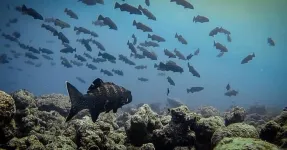(Press-News.org) BUFFALO, N.Y. — Our energy future may depend on high-temperature superconducting (HTS) wires. This technology’s ability to carry electricity without resistance at temperatures higher than those required by traditional superconductors could revolutionize the electric grid and even enable commercial nuclear fusion.
Yet these large-scale applications won’t happen until HTS wires can be fabricated at a price-performance metric equal to that of the plain copper wire sold at your local hardware store.
New University at Buffalo-led research is moving us closer to that goal. In a study published today (Aug. 7) in Nature Communications, researchers report that they have fabricated the world’s highest-performing HTS wire segment while making the price-performance metric significantly more favorable.
Based on rare-earth barium copper oxide (REBCO), their wires achieved the highest critical current density and pinning force — the amount of electrical current carried and ability to pin down magnetic vortices, respectively — reported to date for all magnetic fields and temperatures from 5 kelvin to 77 kelvin.
This temperature range is still extremely cold — minus 451 degrees to minus 321 degrees Fahrenheit — but higher than the absolute zero that traditional superconductors function at.
“These results will help guide industry toward further optimizing their deposition and fabrication conditions to significantly improve the price-performance metric in commercial coated conductors,” says the study’s corresponding author, Amit Goyal, PhD, SUNY Distinguished Professor and SUNY Empire Innovation Professor in the Department of Chemical and Biological Engineering, within the UB School of Engineering and Applied Sciences. “Making the price-performance metric more favorable is needed to fully realize the numerous large-scale, envisioned applications of superconductors.”
HTS wires have many applications
Applications of HTS wires include energy generation, such as doubling power generated from offshore wind generators; grid-scale superconducting magnetic energy-storage systems; energy transmission, such as loss-less transmission of power in high current DC and AC transmission lines; and energy efficiency in the form of highly efficient superconducting transformers, motors and fault-current limiters for the grid.
Just one niche application of HTS wires, commercial nuclear fusion, has the potential for generation of limitless clean energy. In just the last few years, approximately 20 private companies have been founded globally to develop commercial nuclear fusion, and billions of dollars have been invested in developing HTS wires for this application alone.
Other applications of HTS wires include next-generation MRI for medicine, next-generation nuclear magnetic resonance (NMR) for drug discovery and high-field magnets for numerous physics applications. There are also numerous defense applications, such as in the development of all-electric ships and all-electric airplanes.
Presently, most companies around the world fabricating kilometer-long, high performance HTS wires use one or more of the platform technological innovations developed previously by Goyal and his team.
These include rolling assisted biaxially textured substrates (RABiTS) technology, LMOe-enabled ion-beam assisted deposition (IBAD) MgO technology, and nanocolumnar defects at nanoscale spacings via simultaneous phase-separation and strain-driven self-assembly technology. A recent interview by Superconductor Week with Goyal highlights and discusses details of these technologies.
World-record critical current density and pinning force
In the present work reported in Nature Communications, Goyal’s group reports on ultra-high performance, REBCO-based superconducting wires.
At 4.2 kelvin, the HTS wires carried 190 million amps per square centimeter without any external magnetic field, also known as self-field, and 90 million amps per square centimeter with a magnetic field of 7 tesla.
At a warmer temperature of 20 kelvin – the envisioned application temperature for commercial nuclear fusion – the wires could still carry over 150 million amps per square centimeter self-field and over 60 million amps per square centimeter at 7 tesla.
In terms of critical current, this corresponds to a 4-millimeter-wide wire segment at 4.2 kelvin having a supercurrent of 1,500 amps at self-field and 700 amps at 7 tesla. At 20 kelvin, it’s 1,200 amps at self-field and 500 amps at 7 tesla.
It’s worth noting that the team’s HTS film, despite being only 0.2 microns-thick, can carry a current comparable to that of commercial superconducting wires with HTS film almost 10 times thicker.
As for pinning force, the wires showed a strong ability to hold magnetic vortices pinned or in place, with forces of about 6.4 teranewtons per cubic meter at 4.2 kelvin and about 4.2 teranewton per cubic meter at 20 kelvins, both under a 7 tesla magnetic field.
These are the highest values of critical current density and pinning force reported to date for all magnetic fields and operating temperatures from 5 kelvin to 77 kelvin.
“These results demonstrate that significant performance enhancements are still possible and hence the associated reduction in cost that could potentially be realized in optimized, commercial HTS wires,” Goyal says.
How high-performance wire was fabricated
The HTS wire segment was fabricated on substrates using the (IBAD) MgO technology and using the nanocolumnar defects via simultaneous phase-separation and strain-driven self-assembly technology. The self-assembly technology allows incorporation on insulating or non-superconducting nanocolumns at nan0scale spacings within the superconductor. These nanodefects can pin the superconducting vortices, allowing for higher supercurrents.
“The high critical current density was made possible by a combination of pinning effects from rare-earth doping, oxygen-point defects and insulating barium zirconate nanocolumns and their morphologies,” Goyal says.
“The HTS film was made using an advanced pulsed laser deposition system via careful control of deposition parameters,” adds Rohit Kumar, postdoctoral fellow in the UB Laboratory for Heteroepitaxial Growth of Functional Materials and Devices, which Goyal leads.
In pulsed laser deposition, a laser beam impinges on a target material and ablates material that is deposited as a film on an appropriately placed substrate.
“We also conducted atomic-resolution microscopy using the most advanced microscopes at the Canadian Center for Electron Microscopy at McMaster University for characterization of nanocolumnar and atomic-scale defects and also conducted some superconducting property measurements at the Università di Salerno in Italy," Goyal says.
The Office of Naval Research (ONR) supported this fundamental research toward development of superior HTS wires. Goyal is principal investigator on the project.
Goyal’s research has had a significant impact on the field of HTS, both in fundamental materials science and in the transition of scientific discoveries from the laboratory to the marketplace.
He was elected to the National Academy of Engineering for his contributions to the field of high-temperature superconductivity. He has authored or co-authored more than 360 technical publications, including 45 invited book chapters and papers, and has co-edited six books. He has given more than 30 plenary and keynote talks, and more than 180 invited presentations at national and international conferences. He has 88 issued patents comprising 70 U.S. and 18 international patents, and more than 20 patents pending. He was the most cited author worldwide in the field of high-temperature superconductivity from 1999-2009.
END
World’s highest-performance superconducting wire segment fabricated at UB
New study details how large-scale, cost-effective use of high-temperature superconducting wire is another step closer to reality
2024-08-07
ELSE PRESS RELEASES FROM THIS DATE:
Bacterial gut diversity improves the athletic performance of racehorses
2024-08-07
The composition of gut bacteria of Thoroughbred racehorses at one-month-old can predict their future athletic performance, according to a new study from the University of Surrey. Foals with lower bacterial diversity at 28 days old also had a significantly increased risk of respiratory disease later in life.
Researchers from Surrey's School of Veterinary Medicine and School of Bioscience, led by Professor Chris Proudman, investigated the composition of gut bacteria in Thoroughbred foals bred for flat ...
Fishing is causing frightened fish to flee when they should flirt
2024-08-07
Populations of squaretail grouper face an uncertain future as new research shows fishing that targets their spawning sites is causing males to be repeatedly scared away from their territories during their short mating meet-ups.
By fleeing for safety, individuals are losing valuable time to catch the eye and court female fish.
A study, led by scientists at Lancaster University and published today in Biology Letters, shows that the impacts of fishing that targets squaretail grouper spawning sites goes beyond those fish that are caught, causing widespread behavioural change in those left behind.
These changes impact ability to reproduce. With disrupted mating, fewer offspring ...
Your best friend from high school? Here’s why their genes mattered
2024-08-07
Mom always said, “Choose your friends wisely.” Now a study led by a Rutgers Health professor shows she was onto something: Their traits can rub off on you – especially ones that are in their genes.
The genetic makeup of adolescent peers may have long-term consequences for individual risk of drug and alcohol use disorders, depression and anxiety, the groundbreaking study has found.
“Peers’ genetic predispositions for psychiatric and substance use disorders are associated with an individual's own risk of developing ...
How does an effective cancer therapy damage the heart?
2024-08-07
Cytotoxic T-lymphocyte antigen 4 (CTLA-4) is a protein receptor on T immune cells that prevents the cells from killing other cells, such as cancer cells. Blocking CTLA-4 with a specific antibody is an effective treatment for some cancers, but it can damage the heart. New research published in The FASEB Journal reveals the mechanisms involved in this side effect—a finding that could be used to help prevent it.
Experiments conducted in mice showed that blocking CTLA-4 activates certain T cells called Th17 cells, which increase inflammation. Inhibiting this activation reversed ...
How well will different US forests remove atmospheric carbon in the future?
2024-08-07
Forests absorb carbon by capturing carbon dioxide from the atmosphere, making forest carbon stocks an important resource against climate change. In research published in Ecology and Evolution, investigators examined existing tree regeneration patterns to develop an indicator of potential changes to future carbon stocks across forests in the northeastern and midwestern United States.
The scientists’ comparison of carbon stock predictions from tree and seedling composition suggested that 29% of plots were poised ...
Medical issues experienced by women and children after returning from Hamas captivity
2024-08-07
Among the 250 individuals who were kidnapped during the Hamas terror attack on Israeli towns in October 2023, 19 children and 7 women were released and admitted to Schneider Children's Medical Center of Israel after approximately 50 days in captivity, during a cease-fire deal. A new study published in Acta Paediatrica reports on the physical and psychological state of these returnees upon their return.
The most common clinical findings included significant weight loss, psychological trauma, complications of poor hygiene (such as head lice), and complications of recent shrapnel injuries. Tests revealed that returnees also often had ...
Do dieticians have weight biases towards themselves and others?
2024-08-07
In a survey-based study, UK dietitians exhibited significant weight stigma, both towards themselves and towards others.
The study in the Journal of Human Nutrition and Dietetics involved an online survey completed in 2022 by 402 registered dietitians aged 20–70 years old. Most respondents reported personally experiencing weight stigma prior to (51%) and after becoming (59.7%) registered dieticians, and nearly a quarter (21.1%) felt that their weight influenced their own ability to perform as a dietitian.
Weight stigma was experienced across the weight spectrum. Participants reported explicit (or conscious) weight bias attitudes, moderate beliefs that obesity is ...
Can nanomaterials enhance plant tolerance to high soil salt levels?
2024-08-07
Soil salt concentrations above the optimal threshold for plant growth can threaten global food security by compromising agricultural productivity and crop quality. An analysis published in Physiologia Plantarum examined the potential of nanomaterials—which have emerged over the past decade as a promising tool to mitigate such “salinity stress”—to address this challenge.
Nanomaterials, which are tiny natural or synthetic materials, can modulate a plant’s response to salinity stress ...
Study on planet-warming contrails “a spanner in the works” for aviation industry
2024-08-07
Modern commercial aircraft flying at high altitudes create longer-lived planet-warming contrails than older aircraft, a new study has found.
The result means that although modern planes emit less carbon than older aircraft, they may be contributing more to climate change through contrails.
Led by scientists at Imperial College London, the study highlights the immense challenges the aviation industry faces to reduce its impact on the climate. The new study also found that private jets produce more contrails than previously thought, ...
Sea lion camera crews help researchers explore previously unmapped ocean habitats
2024-08-07
The world’s seabeds are little explored, and the knowledge we have is patchy. Using remotely operated underwater vehicles to learn about seabeds is expensive, requires certain weather conditions, and is difficult in deep, remote, and offshore habitats.
To circumvent these challenges, researchers in Australia have now enlisted endangered Australian sea lions (Neophoca cinerea) to carry cameras. The resulting videos allowed the researchers to identify previously unmapped benthic habitats used by the sea lions on the continental shelf. They published their results in Frontiers in Marine Science.
“Using ...
LAST 30 PRESS RELEASES:
Heart-brain connection: international study reveals the role of the vagus nerve in keeping the heart young
Researchers identify Rb1 as a predictive biomarker for a new therapeutic strategy in some breast cancers
Survey reveals ethical gaps slowing AI adoption in pediatric surgery
Stimulant ADHD medications work differently than thought
AI overestimates how smart people are, according to HSE economists
HSE researchers create genome-wide map of quadruplexes
Scientists boost cell "powerhouses" to burn more calories
Automatic label checking: The missing step in making reliable medical AI
Low daily alcohol intake linked to 50% heightened mouth cancer risk in India
American Meteorological Society announces Rick Spinrad as 2026 President-Elect
Biomass-based carbon capture spotlighted in newly released global climate webinar recording
Illuminating invisible nano pollutants: advanced bioimaging tracks the full journey of emerging nanoscale contaminants in living systems
How does age affect recovery from spinal cord injury?
Novel AI tool offers prognosis for patients with head and neck cancer
Fathers’ microplastic exposure tied to their children’s metabolic problems
Research validates laboratory model for studying high-grade serous ovarian cancer
SIR 2026 delivers transformative breakthroughs in minimally invasive medicine to improve patient care
Stem Cell Reports most downloaded papers of 2025 highlight the breadth and impact of stem cell research
Oxford-led study estimates NHS spends around 3% of its primary and secondary care budget on the health impacts of heat and cold in England
A researcher’s long quest leads to a smart composite breakthrough
Urban wild bees act as “microbial sensors” of city health.
New study finds where you live affects recovery after a hip fracture
Forecasting the impact of fully automated vehicle adoption on US road traffic injuries
Alcohol-related hospitalizations from 2016 to 2022
Semaglutide and hospitalizations in patients with obesity and established cardiovascular disease
Researchers ‘listen in’ to embryo-mother interactions during implantation using a culture system replicating the womb lining
How changing your diet could help save the world
How to make AI truly scalable and reliable for real-time traffic assignment?
Beyond fragmented markets: A new framework for efficient and stable ride-pooling
Can shape priors make road perception more reliable for autonomous driving?
[Press-News.org] World’s highest-performance superconducting wire segment fabricated at UBNew study details how large-scale, cost-effective use of high-temperature superconducting wire is another step closer to reality


